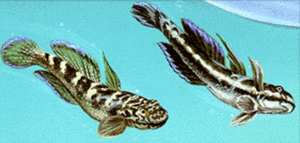Nopoli rockclimbing goby facts for kids
Quick facts for kids Nopoli rockclimbing goby |
|
|---|---|
 |
|
| Conservation status | |
| Scientific classification | |
| Synonyms | |
|
The Nopoli rockclimbing goby (scientific name: Sicyopterus stimpsoni) is a special type of fish found only in Hawaii. People also call it the oopu nopili or Stimpson's goby. This fish is known for its amazing ability to climb waterfalls! It can grow up to about 19.8 centimeters (almost 8 inches) long. It's an amphidromous fish, which means it lives part of its life in freshwater and part in saltwater.
Contents
Life in the Stream
Young Nopoli gobies start their lives in the ocean. As they grow, they move from the saltwater to freshwater streams. This move happens just before their mouths change shape. After this change, they can no longer eat tiny ocean creatures called plankton.
These fish eat mostly algae that grows on rocks. The amount of algae depends on the water levels in the island streams. So, the fish's food supply is linked to the stream's natural water cycles.
Habitat and Diet
Adult Nopoli rockclimbing gobies live in the upper parts of clear, fast-moving mountain streams. They like places with clean gravel and rocks that don't have much dirt or sand. This allows algae to grow well on the rock surfaces.
You can find this fish on all the Hawaiian Islands. However, it has become quite rare on O‘ahu. The Nopoli goby is a herbivore, meaning it only eats plants. It feeds on tiny plant-like organisms called diatoms and stringy filamentous algae.
These fish are very protective of their feeding spots. They even "farm" their own food! They encourage a short layer of diatoms, filamentous algae, and blue-green algae to grow on the top surfaces of stones and boulders. The male fish guard these special "gardens." These gardens are also important during courtship.
Reproduction and Climbing
During the breeding season, male Nopoli gobies show off bright blue and red colors. These colors can change depending on the fish's mood. The females lay their eggs on rocks, and the males fertilize them.
Once the eggs hatch, the tiny baby fish are immediately washed downstream into the sea. They grow and develop in the ocean. Later, as juveniles, they return to the freshwater pools upstream. They will live in these pools for several years.
To reach these upstream pools, the young gobies must climb up vertical rocks, even under and next to very tall waterfalls! They wait to climb until their mouths have moved from facing forward to being underneath their bodies. This change happens very quickly, in just two days. This mouth change helps them switch their diet from eating many different things to almost only eating algae from rock surfaces. It also allows them to climb slippery waterfall rocks. They use their mouths and special suckers on their bellies (pelvic fins) to stick to the rocks.
Who Eats the Goby?
Nopoli rockclimbing gobies can be eaten by black-crowned night herons. As they migrate upstream through the river mouth, they can also be prey for larger fish like Caranx species, Polydactylus sexfilis, and Sphyraena barracuda.
Conservation Status
Hawaii has seven native freshwater fish species, and five of them are a type called gobioid. Three of these gobies, including the Nopoli rockclimbing goby (S. stimpsoni), Awaous stamineus, and Lentipes concolor, are amphidromous stream dwellers. This means they are specially adapted to live in the steep, fast-moving streams of Hawaii's mountains. Other native gobies, like Eleotris sandwicensis and Stenogobius hawaiiensis, cannot pass through steep rapids.
Because these fish are so specialized for their habitat, they are very sensitive to any changes or disturbances in the streams. Protecting their natural environment is very important for their survival.
Name Origin
The scientific name stimpsoni honors William Stimpson (1832-1872). He was a marine biologist who collected the first example of this fish used for its scientific description.
See also
 In Spanish: Sicyopterus stimpsoni para niños
In Spanish: Sicyopterus stimpsoni para niños
References
- Froese, Rainer and Pauly, Daniel, eds. (2006). "Eleotris sandwicensis" in FishBase. April 2006 version.
- Cullen JA, Maie T, Schoenfuss HL and Blob RW (2012) "Evolutionary novelty versus exaptation: Oral kinematics in feeding versus climbing in the waterfall-climbing Hawaiian goby Sicyopterus stimpsoni" PLoS ONE, 8(1): e53274.


